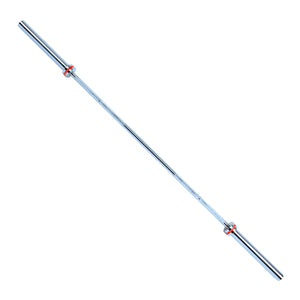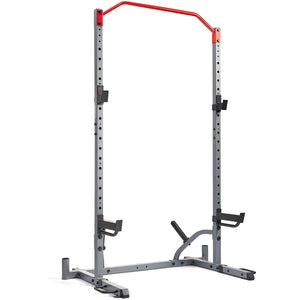Resistance training popularity is on the rise, and fitness professionals everywhere could not be happier. Cardio exercise has had a grip on the fitness industry for the last several decades, and not without good reason. Cardiovascular training is vastly important for overall health and wellness. However, cardio hype frequently comes at the expense of strength training, with common misconceptions such as “getting too bulky” or “not burning enough calories” often cited as the main drivers of this inverse relationship.
But strength training is finally having its moment. With a robust database of research backing all the amazing benefits that weightlifting offers – like fighting chronic diseases, increasing health span, and improving body composition – the strength training craze has finally caught on.(1)
While any type of resistance training delivers big on the aforementioned health benefits, heavy strength training can be a particularly effective way to reap these rewards. “Heavy lifting can enhance your overall coordination, balance, and stability,” explains ACSM certified personal trainer, Dee Cervantes, who has been training and competing in Olympic weightlifting for 7 years. “It’s also a great way to increase bone density, improve joint health, boost metabolism, and enhance overall physical and mental well-being.”
With all those added benefits, how can you resist? If that’s not enough motivation to get you started, this article will cover all the amazing benefits of heavy lifting, the different types you can try, and how to get started. Let’s go!
Will Heavy Lifting Make Me “Bulky”?
Let’s all take a deep breath and put this common misconception to rest once and for all. Many people, typically women, tend to avoid strength training for fear of gaining too much muscle. “This fear is unfounded and simply not true,” states Cervantes. “Even guys who aim to bulk up often struggle to achieve their desired results. It takes many years of heavy lifting to gain significant bulk.”
Research confirms this to be true. A 2017 scientific study found that, when comparing high-load to low-load resistance training, subjects in both groups had similar levels of muscle hypertrophy (increased muscle mass).(2) In fact, when done consistently, it aids in building muscle and reducing body fat percentage to create that “toned” look that women often seek.
Strength training doesn’t have to be scary. You might even find this method of training gives you better results than other programs you’ve tried! So, don’t let fear keep you from missing out on the health and fitness benefits of heavy lifting.
What are the Benefits of Heavy Lifting?
Beyond aesthetics and weight loss, there are countless reasons to try lifting heavy!
Improved Movement Control
Strength training contributes to greater body awareness (also known as proprioception) and improved movement control.(3) You will gain a better understanding of how your body moves and ways you can create better quality movement.
Injuries and unwanted aches and pains often come from over-compensating or not being aware of movement patterns that might be detrimental to your health. Strength training with heavy loads can be a great way to combat these issues.
Increase Bone Mineral Density
Lifting weights comes with many active aging benefits, but one of the most important advantages is that it increases bone mineral density.(4) As we age, falls become more common. Unfortunately, these falls often carry a higher risk of bone fractures. You can protect yourself from this type of injury by maintaining a consistent strength routine.
It is important to note that bone adaptations are not system-wide, meaning that if you only work your legs, only the bones in your lower body will get stronger. All the more reason to hit your whole body!
Combat Chronic Illness
Want to decrease your risk for chronic illness, such as heart disease, cancer, and type II diabetes? Strength training! Studies show that this method of exercise is highly effective, not only in preventing these types of diseases but also in expediting recovery and reducing the likelihood of recurrence if you suffer from an illness.(1)
Prioritizes Performance-Based Goals
This can feel refreshing if you’re getting tired of focusing too much on body image. Strength training places emphasis on performance and how you can improve your lifts with each workout, week, and cycle of your program. “Focusing on performance rather than aesthetics shifts the emphasis from solely appearance-based goals to tangible, measurable achievements,” states Cervantes. “By setting performance-related goals, such as improving your squat or deadlift strength, you can enhance your motivation and sense of accomplishment.”
The best thing about performance-based goals is that they release some of the pressure related to weight loss or how your body looks. However, these results will manifest naturally if you are consistent with your program.
Training Can Feel More Manageable
High-intensity interval training (HIIT) can sometimes feel mentally overwhelming or may not be suitable for your body on days when you need a little more rest. Contrary to what you might expect, heavy lifting can feel like quite the opposite! Heavy lifting requires fewer repetitions since you are moving a greater amount of weight and need more rest in between sets so you can fully recover. While the lifts themselves are of course challenging, you will get more of a reprieve throughout your workout, making it feel a little more manageable.
What Different Types of Heavy Lifting Can I Try?
There are many types of heavy resistance training, so test out a few and see which method fits your training style best. “Each method emphasizes different aspects of strength and power development,” advises Cervantes. Evaluate your personal fitness goals to determine which type aligns most closely with your aim.
Traditional Strength Training
This is the type of training you probably think of when you think of strength training. Dumbbells, kettlebells, and barbells are all commonly used for traditional strength training workouts. Choose some exercises, a heavier weight (one that you can do about 3-8 reps with), and get to lifting!
Is this a fit for you? You might like this type of training if your priority is functional fitness. You can incorporate a variety of lifts, and make your program custom to you.
Powerlifting
Powerlifting tests your strength in three primary lifts: the squat, deadlift, and bench press. Your training will consist of other accessory movements, but your overall goal is to move more weight in these three lifts.
Is this a fit for you? If you like consistency and are a fan of the squat, deadlift, and bench press, then you can’t go wrong with this type of training. Plus, you will feel satisfied and accomplished as beat your PR again and again.
Olympic Weightlifting
Olympic lifting is similar to powerlifting in that it focuses on a few specific exercises: the snatch and the clean and jerk. But that’s where the similarities end. Where powerlifting is slower by nature due to the amount of weight being lifted, Olympic lifting emphasizes muscular power. While there is a big learning curve when it comes to Olympic lifts, you can expect your training to not only boost your strength, but also your mobility, coordination, power, and speed.
“I particularly appreciate Olympic weightlifting due to its dynamic and explosive nature,” adds Cervantes. “It requires a combination of strength, speed, and technique, making it both physically and mentally stimulating.”
Is this a fit for you? If you are well-seasoned when it comes to strength workouts, this could be a great way to challenge yourself in a new way. Additionally, if you want your training to focus on more than just strength, this is an excellent way to do it.
Strongman Training
If you instantly thought of those big guys pulling semi-trucks and lifting cars, you’re on the right track. Strongman training is the least common type of heavy strength training, and has 6 primary lifts: Log Press, Atlas Stones, Yoke, Axle Deadlift, Truck Pull, Farmers Walk, and Sandbag carry. Although these seem far out of the realm of “normal” strength training, at its core Strongman Training consists of various push/pull movements that are quite functional.(5)
Is this a fit for you? You may not have access to the equipment needed to perform the above lifts, but you can replicate this style of training in your own gym with readily available equipment. Think kettlebells, medicine balls, sandbags, or the trap bar. If you like the idea of your training closely mimicking everyday movements, this type of training might be right up your alley.
How to Get Started
The best thing you can do when starting up a new-to-you training plan is to consult an expert. Heavy strength training is no different, and arguably, it's even more important to have a knowledgeable professional coach guide you through the initial stages of your program. According to Cervantes, starting out with a coach is important for five reasons:
- Proper Technique: A coach can teach you the correct form and technique for each exercise. This ensures that you perform movements safely and effectively, reducing the risk of injury and maximizing the benefits of your workout.
- Individualized Guidance: A coach can assess your fitness level, goals, and any specific limitations or concerns you may have. They can then create a personalized workout plan tailored to your needs, ensuring that you progress at an appropriate pace and address any weaknesses.
- Injury Prevention: A coach can help prevent injuries by teaching you proper warm-up and cool-down techniques, guiding you on appropriate exercise selection, and monitoring your form and technique during workouts. They can also modify exercises or suggest alternatives if you have any pre-existing conditions or injuries.
- Progression and Adaptation: A coach can help you progress your workouts over time by gradually increasing the intensity, adjusting exercises, and incorporating new challenges. They can also help you adapt your workouts if you hit a plateau or encounter obstacles along the way.
- Knowledge and Education: A coach is a valuable source of knowledge and can educate you on various aspects of fitness, such as nutrition, recovery, and goal setting. They can provide you with evidence-based information and help you make informed decisions about your health and fitness journey.
If consulting a coach is not accessible for you, consider finding a program that focuses on basic compound lifts so you can master the fundamentals before progressing (may we suggest the SunnyFit® App? 😉) “It's important to prioritize proper form and technique to prevent injuries and ensure optimal progress,” says Cervantes. “I would also advise starting with lighter weights to gradually build strength and confidence before progressing to heavier loads.”
“Remember, consistency and patience are key when starting any new training program,” says Cervantes. “Start slowly, listen to your body, and gradually increase the intensity and volume of your workouts over time.” Begin with a pace and intensity that is manageable to you. If something doesn’t feel right, listen to your body, but don’t get discouraged. It takes time to master these movements!
1. Katrina L. Piercy, P. (2018, November 20). Physical activity guidelines for Americans. JAMA. https://jamanetwork.com/journals/jama/article-abstract/2712935. Accessed 9 October 2023.
2. Schoenfeld, B. J., Grgic, J., Ogborn, D., & Krieger, J. W. (2017). Strength and hypertrophy adaptations between low- vs. high-load resistance training: A systematic review and meta-analysis. Journal of Strength and Conditioning Research, 31(12), 3508–3523. https://doi.org/10.1519/jsc.0000000000002200. Accessed 9 October 2023.
3. Borges-Silva, F., Martínez-Pascual, M., Colomer-Poveda, D., Márquez, G., & Romero-Arenas, S. (2022b). Does heavy-resistance training improve mobility and perception of quality of life in older women? Biology, 11(5), 626. https://doi.org/10.3390/biology11050626. Accessed 9 October 2023.
4. O’Bryan, S. J., Giuliano, C., Woessner, M. N., Vogrin, S., Smith, C., Duque, G., & Levinger, I. (2022). Progressive resistance training for concomitant increases in muscle strength and bone mineral density in older adults: A systematic review and meta-analysis. Sports Medicine, 52(8), 1939–1960. https://doi.org/10.1007/s40279-022-01675-2. Accessed 9 October 2023.
5. What is strongman training? your complete guide. strengthambassadors.com. (2023, June 1). https://strengthambassadors.com/blog/what-is-strongman-training-your-complete-guide/. Accessed 9 October 2023.



























Add Your Name & Email
Please enter your name and email to continue.We won’t display your email publicly.